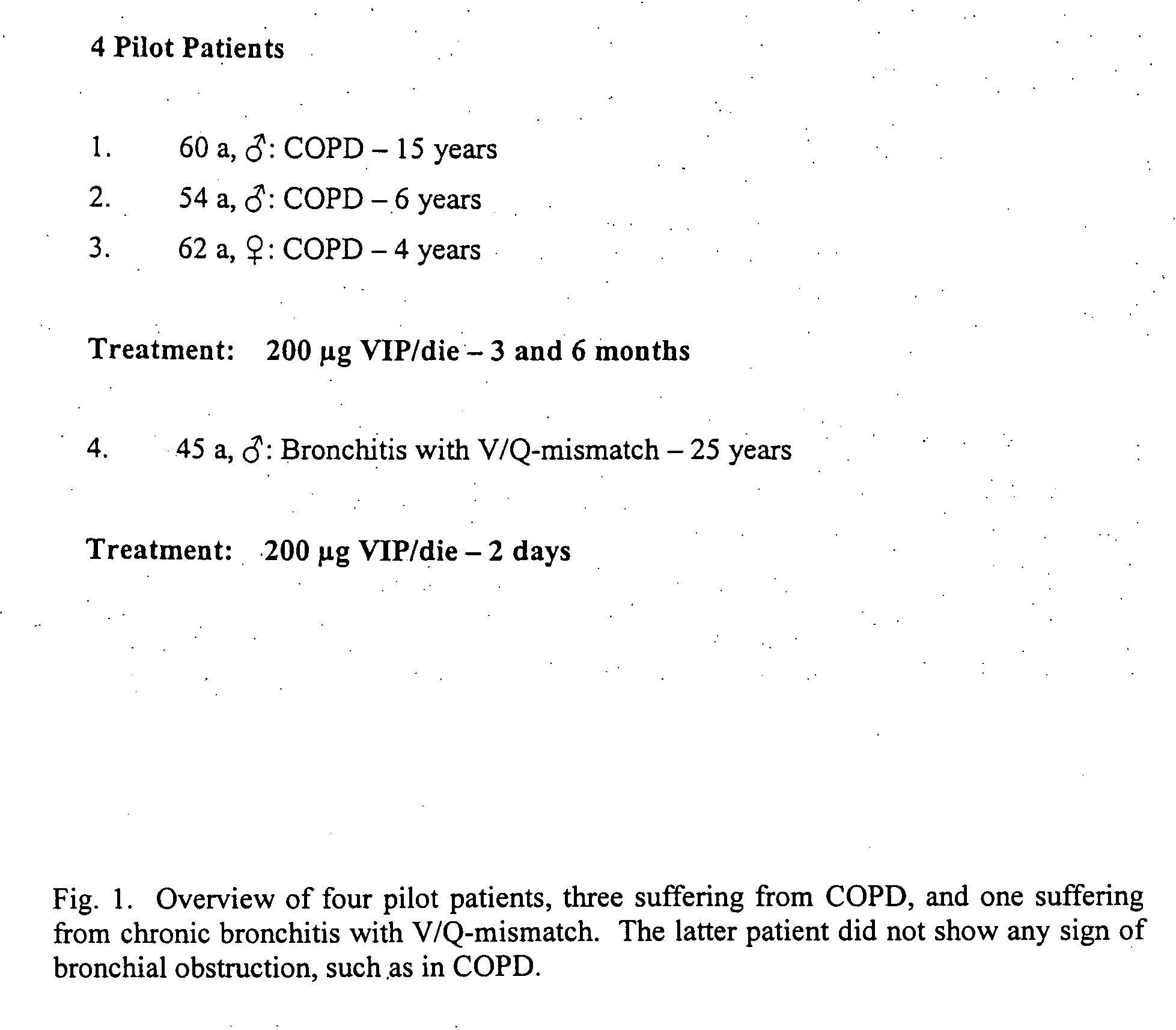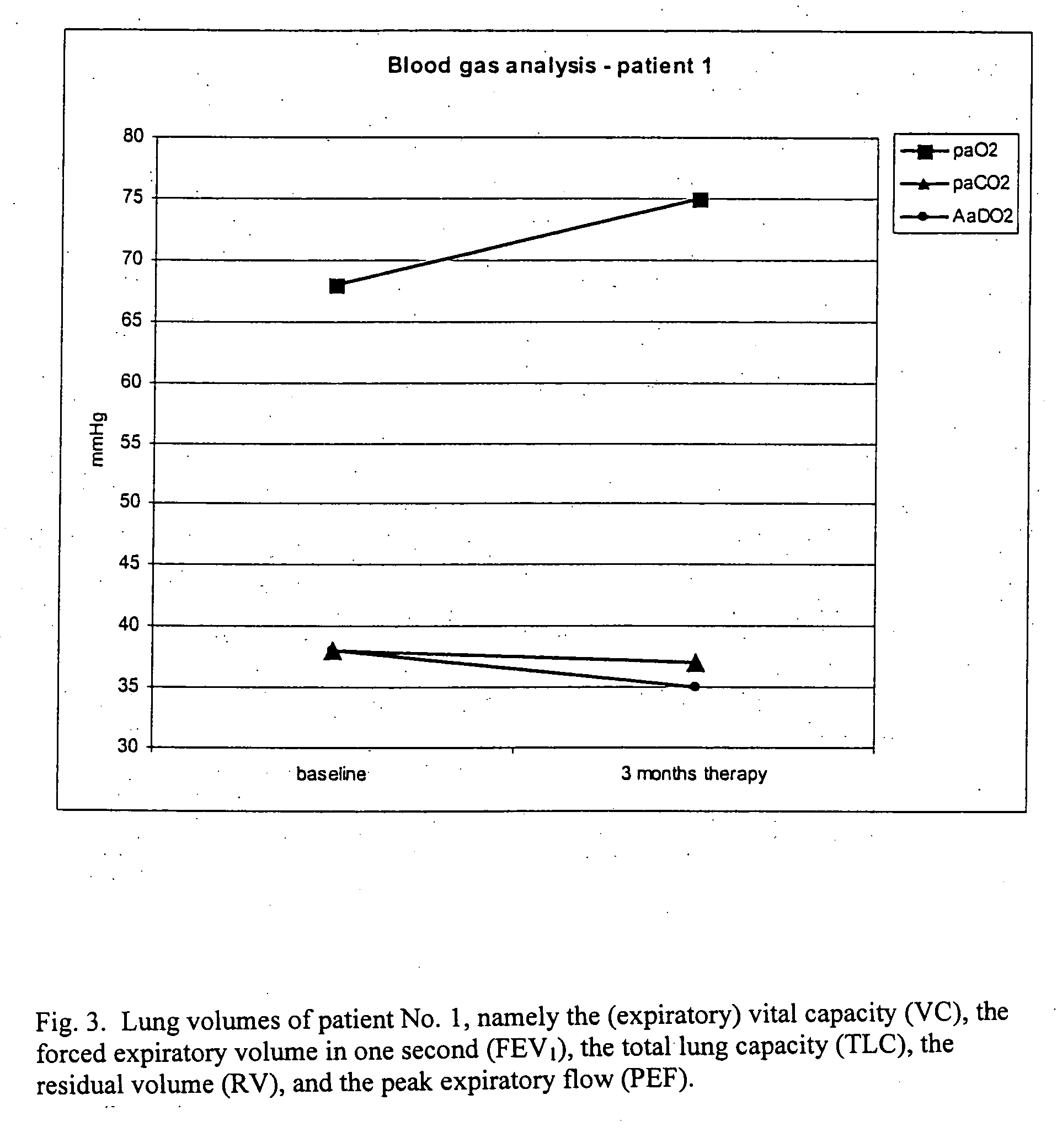Method for treating lung diseases associated with ventilation-perfusion mismatches
a technology of ventilation and mismatch, applied in the direction of antiinfectives, carrier-bound/immobilised peptides, botany apparatus and processes, etc., can solve the problems of increasing the occurrence of bacterial infections, difficult breathing, and increasing the mucus production in the airway, so as to improve or recover the general state of health
- Summary
- Abstract
- Description
- Claims
- Application Information
AI Technical Summary
Benefits of technology
Problems solved by technology
Method used
Image
Examples
example 1
Patient No. 1
[0075] Patient No. 1 suffered from severe COPD with no sign of pulmonary hypertension. The patient inhaled VIP (200 μg in 3 ml NaCl 0.9%) for 15 minutes via the MicroDrop Master Jet (MPV, Truma, Germany) using a particle size of 3 μm to ensure alveolar deposition of the substance. Lung function parameters were measured at baseline (before inhalation of VIP) and after 3 months of therapy. FIG. 2 shows the lung volumes of patient No. 1, namely the (expiratory) vital capacity (VC), the forced expiratory volume in one second (FEV1), the total lung capacity (TLC), the residual volume (RV), and the peak expiratory flow (PEF). FIG. 3 shows the blood gas analysis (paO2: partial arterial oxygen pressure; paCO2: partial arterial carbon dioxide pressure; and AaDO2: arterial-alveolar oxygen pressure difference) of patient No. 1 at baseline and three months later. FIG. 4 shows a six minute walking distance of patient No. 1 at baseline and three months later.
example 2
Patient No. 2
[0076] Patient No. 2 had severe COPD symptoms. The patient inhaled VIP (200 μg in 3 ml NaCl 0.9%) for 15 minutes via the MicroDrop Master Jet (MPV, Truma, Germany) using a particle size of 3 μm to provide alveolar deposition of the substance. Lung function parameters before and after 6 months of inhalation of VIP are given in FIG. 5. FEV1 (forced expiratory volume in one second) and PEF (peak expiratory flow); blood gas analysis (paO2: partial arterial oxygen pressure; paCO2: partial arterial carbon dioxide pressure; AaDO2: Arterial-alveolar oxygen pressure difference) of patient No. 2 at baseline and 6 months later are shown in FIG. 6.
example 3
Patient No. 3
[0077] Patient No. 3 also suffered from severe COPD with no sign of pulmonary hypertension. The patient inhaled VIP (200 μg in 3 ml NaCl 0.9%) for 15 minutes via the MicroDrop Master Jet (MPV, Truma, Germany) using a particle size of 3 μm to ensure alveolar deposition of the substance. FIG. 7 shows the lung volume of patient No. 3, namely the (expiratory) vital capacity (VC), the forced expiratory volume in one second (FEV1), the total lung capacity (TLC), the residual volume (RV), and the peak expiratory flow (PEF). Lung function parameters were measured at baseline (before inhalation of VIP) and after 6 months of therapy. FIG. 8 shows the blood gas analysis (paO2: partial arterial oxygen pressure; paCO2: partial arterial carbon dioxide pressure; AaDO2: arterial-alveolar oxygen pressure difference) of patient No. 3 at baseline and 6 months later.
PUM
| Property | Measurement | Unit |
|---|---|---|
| concentration | aaaaa | aaaaa |
| concentration | aaaaa | aaaaa |
| concentration | aaaaa | aaaaa |
Abstract
Description
Claims
Application Information
 Login to View More
Login to View More - R&D
- Intellectual Property
- Life Sciences
- Materials
- Tech Scout
- Unparalleled Data Quality
- Higher Quality Content
- 60% Fewer Hallucinations
Browse by: Latest US Patents, China's latest patents, Technical Efficacy Thesaurus, Application Domain, Technology Topic, Popular Technical Reports.
© 2025 PatSnap. All rights reserved.Legal|Privacy policy|Modern Slavery Act Transparency Statement|Sitemap|About US| Contact US: help@patsnap.com



